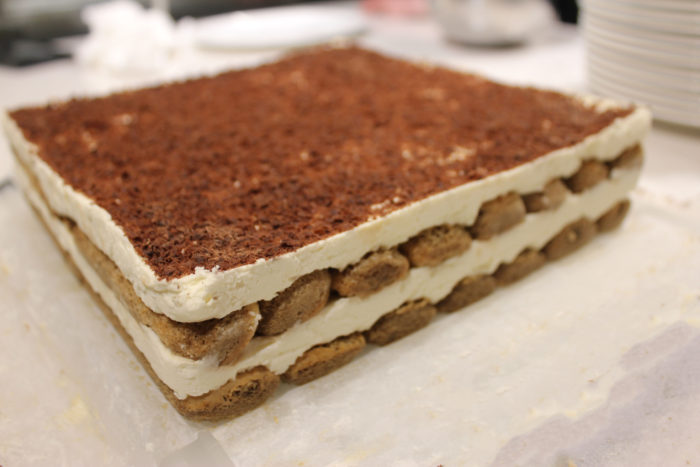
Ordinarily, an exceptional dessert takes some effort. Surely some time. Except, I think, for this Italian classic: tiramisu. It is a snap to prepare and, if you have just some basic artistic/architectural skills, you can make it gloriously beautiful.
We serve this often at Cooking by Book. It’s a fan favorite. We do not make our own lady fingers. We have several Italian bakeries near us. And, Whole Foods makes a killer lady finger. With that head start, this is an easy dessert.
Tiramisu
Yield: 16 servings [16 people at best, more like 8]
Ingredients and Gear:
- 1 cup chilled heavy or whipping cream
- 1 pound mascarpone
- ⅓ cup sugar
- 24 lady fingers (recipes are in Michele’s book or you can purchase)
- 1 cup brewed espresso (or strong coffee) room temperature
- ⅓ cup coffee liqueur (like Kahlua)
- 2 Tbsp unsweetened cocoa powder
- And a 9-inch square pan!
Preparation:
STEP 1: Chill the bowl and beaters from the mixer in the refrigerator for 30 minutes prior to making the dessert.
STEP 2: Remove the bowl and beaters from the refrigerator. Pour the cream into the bowl and whip it at high speed until it is smooth (not grainy; overwhipped) and holds a peak.
STEP 3: In a large bowl, whisk together the mascarpone and sugar until smooth. With a spatula, gently fold 1/3 of the whipped cream into the mascarpone mixture to lighten it. Gently fold in the remaining cream until fully incorporated.
STEP 4: In a bowl, mix the coffee with the coffee liqueur. Quickly dip half of the lady fingers in the coffee and arrange them in a single layer of a 9 x 2 inch square. Top with a layer of mascarpone. Repeat both layers one more time, smoothing out the top layer of mascarpone with the back of a spatula.
STEP 5: Place the cocoa powder in a fine mesh strainer and shake it over the top of the dessert. Cover with plastic wrap and refrigerate 3 to 4 hours or overnight, allowing the flavors to meld before serving.
Source: Adapted from 1000 Italian Recipes from Michele Scicolone
Photo Information: Canon T2i, EFS 60mm Macro Lens, F/3.5 for 1/30th second at ISO‑320
